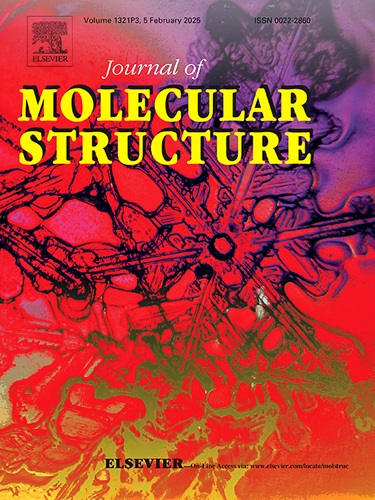Photochromic spiroindolium iodide derivatives; synthesis, Molecular geometry DFT assessment and UV–vis photophysical investigation
IF 4
2区 化学
Q2 CHEMISTRY, PHYSICAL
引用次数: 0
Abstract
Facile synthesis of photochromic spiroindolium iodide derivatives 3a, 3b and 5 via nucleophilic substitution reaction of 1,2,3,3-tetramethyl-3H-indolium iodide with different o‑hydroxy benzaldehyde or naphthaldehyde derivatives. The structure of the synthesized compounds was confirmed by different spectral analyses such as FT-IR,1H NMR, 13C NMR spectra and elemental analysis. The photochromic properties of synthesized compounds were measured via UV–vis photophysical measurements. The photochromism was investigated using UV-spectrophotometer before and after exposure to direct sunlight. Overall, compounds 3a, 3b and 5 shows a new peak at range 500–600 nm in visible region to confirm that the energy absorbed was sufficient to change them to their open structure forms. Then, we present density functional theory (DFT) calculations on the synthesized photochromic compounds 3a, 3b and 5 and their isomeric open forms, aiming to explore their potential thermodynamic stability, molecular geometry, frontier molecular orbitals energy gap investigation as well as their molecular electrostatic potential mapping. By analyzing the influence of UV–vis energy on molecular interactions and electronic transitions, we aim to elucidate the relationship between molecular structure and photochromic behavior.
求助全文
约1分钟内获得全文
求助全文
来源期刊

Journal of Molecular Structure
化学-物理化学
CiteScore
7.10
自引率
15.80%
发文量
2384
审稿时长
45 days
期刊介绍:
The Journal of Molecular Structure is dedicated to the publication of full-length articles and review papers, providing important new structural information on all types of chemical species including:
• Stable and unstable molecules in all types of environments (vapour, molecular beam, liquid, solution, liquid crystal, solid state, matrix-isolated, surface-absorbed etc.)
• Chemical intermediates
• Molecules in excited states
• Biological molecules
• Polymers.
The methods used may include any combination of spectroscopic and non-spectroscopic techniques, for example:
• Infrared spectroscopy (mid, far, near)
• Raman spectroscopy and non-linear Raman methods (CARS, etc.)
• Electronic absorption spectroscopy
• Optical rotatory dispersion and circular dichroism
• Fluorescence and phosphorescence techniques
• Electron spectroscopies (PES, XPS), EXAFS, etc.
• Microwave spectroscopy
• Electron diffraction
• NMR and ESR spectroscopies
• Mössbauer spectroscopy
• X-ray crystallography
• Charge Density Analyses
• Computational Studies (supplementing experimental methods)
We encourage publications combining theoretical and experimental approaches. The structural insights gained by the studies should be correlated with the properties, activity and/ or reactivity of the molecule under investigation and the relevance of this molecule and its implications should be discussed.
 求助内容:
求助内容: 应助结果提醒方式:
应助结果提醒方式:


